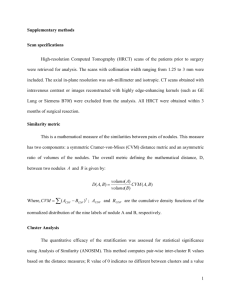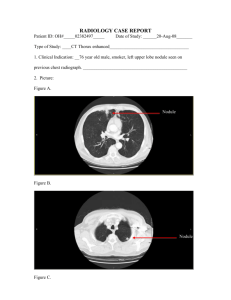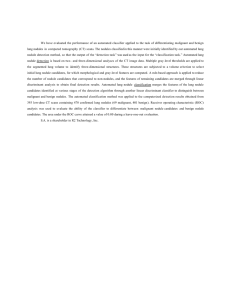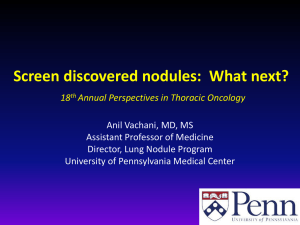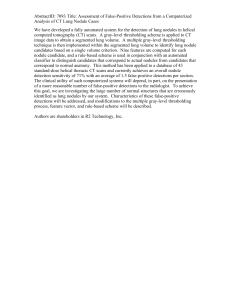BRADYRHIZOBIUM SPP. RHIZOBIUM FREDII
advertisement
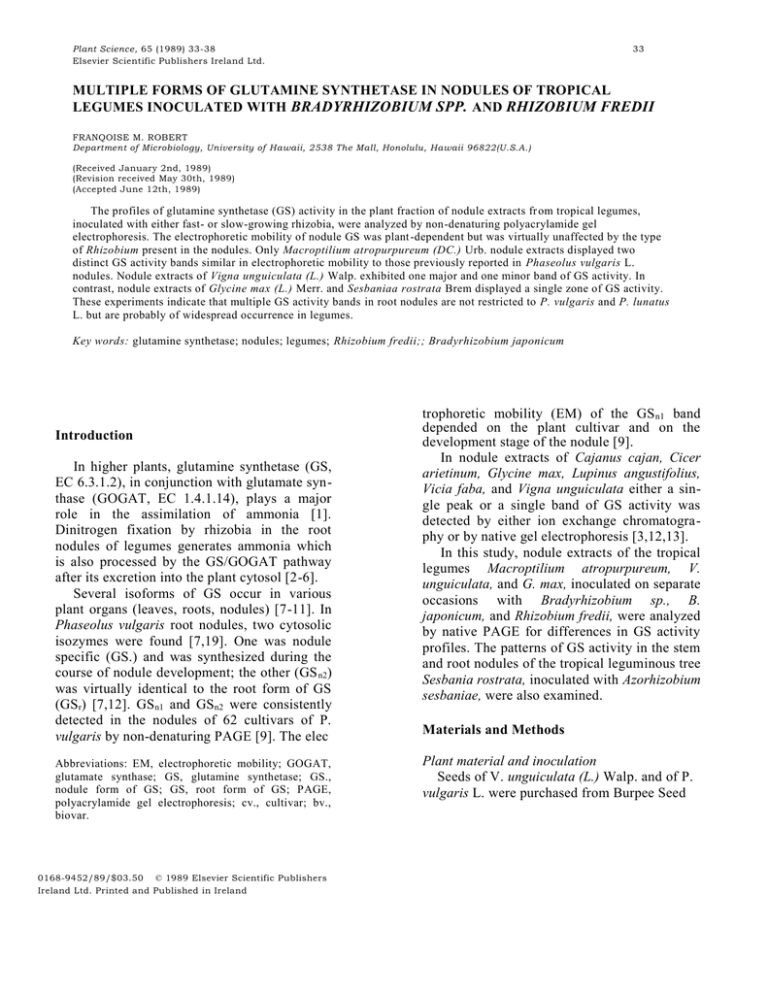
Plant Science, 65 (1989) 33-38 Elsevier Scientific Publishers Ireland Ltd. 33 MULTIPLE FORMS OF GLUTAMINE SYNTHETASE IN NODULES OF TROPICAL LEGUMES INOCULATED WITH BRADYRHIZOBIUM SPP. AND RHIZOBIUM FREDII FRANQOISE M. ROBERT Department of Microbiology, University of Hawaii, 2538 The Mall, Honolulu, Hawaii 96822(U.S.A.) (Received January 2nd, 1989) (Revision received May 30th, 1989) (Accepted June 12th, 1989) The profiles of glutamine synthetase (GS) activity in the plant fraction of nodule extracts fr om tropical legumes, inoculated with either fast- or slow-growing rhizobia, were analyzed by non-denaturing polyacrylamide gel electrophoresis. The electrophoretic mobility of nodule GS was plant -dependent but was virtually unaffected by the type of Rhizobium present in the nodules. Only Macroptilium atropurpureum (DC.) Urb. nodule extracts displayed two distinct GS activity bands similar in electrophoretic mobility to those previously reported in Phaseolus vulgaris L. nodules. Nodule extracts of Vigna unguiculata (L.) Walp. exhibited one major and one minor band of GS activity. In contrast, nodule extracts of Glycine max (L.) Merr. and Sesbaniaa rostrata Brem displayed a single zone of GS activity. These experiments indicate that multiple GS activity bands in root nodules are not restricted to P. vulgaris and P. lunatus L. but are probably of widespread occurrence in legumes. Key words: glutamine synthetase; nodules; legumes; Rhizobium fredii;; Bradyrhizobium japonicum Introduction In higher plants, glutamine synthetase (GS, EC 6.3.1.2), in conjunction with glutamate synthase (GOGAT, EC 1.4.1.14), plays a major role in the assimilation of ammonia [1]. Dinitrogen fixation by rhizobia in the root nodules of legumes generates ammonia which is also processed by the GS/GOGAT pathway after its excretion into the plant cytosol [2-6]. Several isoforms of GS occur in various plant organs (leaves, roots, nodules) [7-11]. In Phaseolus vulgaris root nodules, two cytosolic isozymes were found [7,19]. One was nodule specific (GS.) and was synthesized during the course of nodule development; the other (GS n2) was virtually identical to the root form of GS (GSr) [7,12]. GSn1 and GSn2 were consistently detected in the nodules of 62 cultivars of P. vulgaris by non-denaturing PAGE [9]. The elec Abbreviations: EM, electrophoretic mobility; GOGAT, glutamate synthase; GS, glutamine synthetase; GS., nodule form of GS; GS, root form of GS; PAGE, polyacrylamide gel electrophoresis; cv., cultivar; bv., biovar. 0168-9452/89/$03.50 © 1989 Elsevier Scientific Publishers Ireland Ltd. Printed and Published in Ireland trophoretic mobility (EM) of the GS n1 band depended on the plant cultivar and on the development stage of the nodule [9]. In nodule extracts of Cajanus cajan, Cicer arietinum, Glycine max, Lupinus angustifolius, Vicia faba, and Vigna unguiculata either a single peak or a single band of GS activity was detected by either ion exchange chromatography or by native gel electrophoresis [3,12,13]. In this study, nodule extracts of the tropical legumes Macroptilium atropurpureum, V. unguiculata, and G. max, inoculated on separate occasions with Bradyrhizobium sp., B. japonicum, and Rhizobium fredii, were analyzed by native PAGE for differences in GS activity profiles. The patterns of GS activity in the stem and root nodules of the tropical leguminous tree Sesbania rostrata, inoculated with Azorhizobium sesbaniae, were also examined. Materials and Methods Plant material and inoculation Seeds of V. unguiculata (L.) Walp. and of P. vulgaris L. were purchased from Burpee Seed 2 Co., Clinton, IA; seeds of Glycine max (L.) Merr. cvs. Peking and Williams were provided by Dr. H. Keyser and Dr. B.B. Bohlool respectively; seeds of M. atropurpurem (DC.) Urb. and of S. rostrata Brem were provided by Dr. B.B. Bohlool. The seeds were surfacedsterilized either in 1 : 1 (v/v) Clorox for 20 min. (soybean), or in concentrated H 2S04 for 15 min (Macroptilium; Sesbania), or in 30% H202 for 20 min (Phaseolus). The seeds were germinated for 2 days on filter paper and planted in 6-inch pots containing a 3 : 1(v/v) sterilized mixture of vermiculite and perlite [14]. They were inoculated with a culture of the appropriate rhizobium (10 10 cells/ pot) grown in yeast-extract-mannitol broth [15]. G. max cv. Peking, V. unguiculata cvs. California and Purple Hull, and M. atropurpureum seeds were inoculated with Bradyrhizobium sp. strains TAL 420 and TAL 163, B. japonicum USDA 110, and R. fredii HH003. P. vulgaris cvs. Blue Lake 274 and Green Crop were inoculated with R. leguminosarum biovar phaseoli Viking 1. S. rostrata seeds were inoculated with A. sesbaniae ORS 571. Sesbania stems were inoculated with the same strain after 28 days by using a cotton tip dipped in a broth culture (108 cells/ml). The pot surface was covered with a layer of silicone-coated sand to protect against contamination by airborne rhizobia. The pots were irrigated three times a week alternately with water and N-free Hoagland nutrient solution [16]. The plants were grown in a growth chamber at 25 °C with 16-h days (220 µE m-2 s-1 light) and 8-h nights. Nodule and root harvest Nodules from 28-day-old plants were removed, kept on ice until frozen in liquid nitrogen, and stored at - 70 °C as previously described [9]. Uninoculated roots were harvested after 14 days using the same procedure. At harvest time, S. rostrata root and stem nodules were, respectively, 56 and 28 days old. Preparation of nodule and root extracts To obtain that GS present in the plant cytosol, nodule crude extracts were prepared, as in [9], by grinding 1 g of nodules in an ice-chilled mortar with 2 ml of 0.05 M Tris (hydroxymethyl aminomethane)-HCI buffer at pH 7.5 containing 1.0 mM dithiothreitol. The extract was filtered through eight layers of gauze, centrifuged at 27000 x g to remove plant debris and bacteroids, frozen in liquid nitrogen, and stored at - 70 °C. A crude extract of uninoculated roots (40 g roots/80 ml Tris buffer, was obtained as in [9]. The root GS was partially purified by treating the extract with 1% (w/v) protamine sulfate followed by centrifugation at 27000 x g at 4 °C for 20 min. The supernatant fluid was fractionated with solid (NH 4)2so4 (35-55% saturation). The precipitate was separated from the fluid by centrifugation as before and dissolved in 1 ml of ‘running buffer’ (containing 10 mM Tris-HCI buffer (pH 7.8), 5 mM Na-glutamate, 10 mM MgSO 4, and 10% (v/v) glycerol) [7]. The root extract was then dialyzed against "running buffer." Non-denaturing PAGE Discontinuous native gels [1.5 mm x 14 cm x 12 cm separating gel (7.5%) and a 4-cm stacking gel] were prepared as in [9]. Electrophoresis was carried out at 4°C and at 8 W for 5.5 h. The samples were prepared as in [9] and approximately 120 µg of protein (quantified by Bradford's procedure [17]) was loaded/well. Determination of GS activity bands The transferase assay [18] was used to detect GS activity zones on native gels. Results All of the legumes were effectively nodulated (red nodules, green plants) by the fast and slow-growing strains of Rhizobium used. Figure 1 compares the profiles of the electrophoretic mobility (EM) of nodule GS from herbaceous legumes, inoculated with either R. fredii (fast-growing strain), Bradyrhizobium sp. or B. japonicum (slow-growing strains), with the GS profiles of nodule extracts from P. vulgaris Green Crop used as a reference. The nodules GS from each legume displayed distinc- tive patterns of electrophoretic mobility. In M. atropurpureum two distinct GS bands (GS n1 and GSn2), similar in electrophoretic mobility to those previously reported in P. vulgaris [7,9,19], were detected. Nodule extracts of V. unguiculata cvs. California and Purple Hull showed identical GS n profiles which consisted of one major GS activity band of high EM and of one minor band of slower EM. The latter was barely detectable in nodule extracts of cv. Pur ple Hull housing Bradyrhizobium sp. TAL 163. In contrast, in both G. max cultivars, one single band of nodule GS activity was observed. The EM of nodule GS in the various legumes was virtually unaffected by the type of Rhizobium strain present in the nodules. The GS activity in root extracts was much lower than in nodule extracts and was detectable only after partial purification and concentration (approx. 30 times) of the protein 4 fraction with solid (NH 4)2SO4 GS, activity was demonstrated in all of the root extracts examined; those of M. atropurpureum were omitted due to the scarcity of root material available. A comparison of the EM of GS in nodules and roots (Fig. 2) showed that the distinctive feature of all root extracts was the presence of a single band of GS activity (GS r). The EM of this GS, band was as high or slightly higher than that of the lower GS activity band in nodule extracts of V. unguiculata. In G. max the GS r band was thinner than the single GS band found in the nodules of Peking and Williams cultivars. Both stem and root nodule extracts of S. rostrata showed a single zone of GS activity (Fig. 3). Not enough root material was available to permit a successful extraction and concentration from non-nodulated roots. Discussion The results indicated that the EM of nodule GS activity zones was virtually unaffected by the type of microsymbiont housed in the nodules (Fig. 1). Since the GS investigated here is of plant origin, the regulation of the GS isoform production is under plant control and would more likely depend on the amount of nitrogen fixed than on the type of rhizobium. In contrast, the profiles of nodule GS activity varied greatly with the legume (Fig. 1). The nodule GS activity profiles of M. atropurpureum were similar to those reported for 5 In this study, 2 bands of nodule GS activity (GS.) were detected in both cultivars of V. unguiculata (Fig. 1). Since the upper band is a minor one, it may not have been detectable by ion exchange chromatography in previous studies [12]. Also, the EM of this upper band could increase during nodule development, as seen in P. vulgaris [9]. This would cause the fusion of the upper with the lower band of GS activity and the detection of a single form of GS in the nodules of V. unguiculata. A time-course experiment is needed to verify this hypothesis. These results suggest that multiple GS activities, previously observed in P. vulgaris and P. lunatus [7,9,19], also exist in the plant cytosol fraction of root nodules of other legumes such as M. atropurpureum and V. unguiculata Acknowledgements ' This research was funded in part by Cooperative Agreement (DAN-4177-A-00-6035-00) to the NifTAL Project (Paia, Hawaii) from the Agency for International Development. References 1 2 3 4 some P. vulgaris cultivars whose GSn1 displayed a slow EM [9]. In G. max, both nodule and root extracts produced only one band of GS activity (Figs. 1 and 2) as reported previously [3,12]. 5 6 7 B.J. Miflin and P.J. Lea, Ammonia assimilation, in: B.J. Miflin (Ed.), The Biochemistry of Plants, Academic Press, Vol. 5, 1980, pp.169-202. K.O. Awonaike, P.J. Lea and B.J. Miflin, The location of enzymes of ammonia assimilation in root nodules of Phaseolus vulgaris L. Plant Sci. Lett., 23 (1981) 189195. R.H. McParland, J.G. Guevara, R.R. Becker and H.J. Evans, The purification of the glutamine synthetase from the cytosol of soya-bean root nodules. Biochem. J.,153 (1976) 597-606. J.C. Meeks, C.P. Wolk, N. Schilling, P.W. Shaffer, Y. Avissar and W.S. Chien, Initial organic products of fixation of ['9N]dinitrogen by root nodules of soybean (Glycine max). Plant Physiol., 61 (1978) 980-983. T. Ohyama and K. Kumazawa, Nitrogen assimilation of soybean nodules. I. The role of GS/GOGAT system in the assimilation of ammonia produced by N Z fixation. Soil Sci. Plant Nutr., 26 (1980)109-115. D. Sen and H.M. Schulman, Enzymes of ammonia assimilation in the cytosol of developing soybean root nodules. New Phytol., 85 (1980) 243-250. J.V. Cullimore, M. Lara, P.J. Lea and B.J. Miflin, 6 8 9 10 11 12 Purification and properties of two forms of glutamine synthetase from the plant fraction of Phaseolus root nodules. Planta,157 (1983) 245-253. B. Hirel, C. Weatherly, C. Cretin, C. Bergougnoux and P. Gadal, Multiple subunit composition of chloroplastic glutamine synthetase of Nicotiana tabacum L. Plant Physiol., 74 (1984) 448-450. F.M. Robert and P.P. Wong, Isoenzymes of glutamine synthetase in Phaseolus vulgaris L. and Phaseolus lunatus L. root nodules. Plant Physiol., 81 (1986) 142148. S.F. McNally, B. Hirel, P. Gadal, A.F. Mann and G.R. Stewart, Glutamine synthetase of higher plants. Evidence for a specific isoform content related to their possible physiological role and their compartmentation within the leaf. Plant Physiol., 72 (1983) 22-25. S.V. Tingey, E.L. Walker and G.M. Coruzzi, Glutamine synthetase genes of pea encode distinct polypeptides which are differentially expressed in leaves, roots and nodules. EMBO J., 6 (1987)1-9. M. Lara, J.V. Cullimore, P.J. Lea, B.J. Miflin, A.W.B. Johnston and J.W. Lamb, Appearance of a novel form of plant glutamine synthetase during nodule development in Phaseolus vulgaris L. Planta, 157 (1983) 254258. 13 J.G. Robertson, K.J.F. Farnden, M.P. Warburton and J.M. Banks, Induction of glutamine synthetase during nodule development in lupin. Aust. J. Plant Physiol., 2 (1975) 265-272. 14 J.R. Manhart and P.P. Wong, Nitrate reductase activities of rhizobia and the correlation between nitrate reduction and nitrogen fixation. Can. J. Microbiol., 25 (1979) 1169-1174. 15 F.M. Robert and E.L. Schmidt, Population changes and persistence of Rhizobium phaseoli in soil and rhizospheres. Appl. Environ. Microbiol., 45 (1983) 550-556. 16 D.R. Hoagland and D.I. Arnon, The water culture method for growing plants without soil. California Experimental Station Standard circular No. 347 (1938). 17 M.M. Bradford, A rapid and sensitive method for the quantitation of microgram quantites of protein utilizing the principle of protein-dye binding. Anal. Biochem., 72 (1976) 248-254. 18 D.H.P. Barratt, Method for the detection of glutamine synthetase activity on starch gels. Plant Sci. Lett., 18 (1980) 249-254. 19 J.V. Cullimore, P.J. Lea and B.J. Miflin, Multiple forms of glutamine synthetase in the plant fraction of Phaseolus root nodules. Isr. J. Bot., 31 (1982)155-162.
